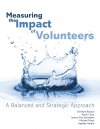Imagine if the only measure of a salaried employee’s worth was the number of hours worked. Is the way to improve performance to work more hours? Or is it to work smarter or to be innovative?
We have already mentioned the limitations of purely statistical reporting on the number of volunteers and the number of hours they serve. If you focus only on these data (in the current climate of continuous improvement), the only thing open to improvement is the number of volunteers and hours! So volunteer resources managers burden themselves with having to constantly provide more and more and more volunteers year after year. There is no way to achieve this expectation successfully, because the number of volunteers and the hours per staff assigned to manage them (i.e., our span of control) are finite. We are setting ourselves up to fail.
Even more important, increasing the number of volunteers may not address real needs and may even be a detriment. Is it better to have 100 volunteers each giving ten hours a month or 25 volunteers giving ten hours a week? Both groups are giving 1,000 hours a month; however, you are managing seventy-five fewer volunteers in the second example. And are all volunteers interchangeable? It may be that an organization has many volunteers but they cannot work on the schedule needed or are not qualified or trained to do the most pressing work. And does the staff possess the skills and the time to properly support endless numbers of volunteers?
Another statistic often reported but woefully misunderstood is turnover rate: whether we are retaining volunteers over time or continually bringing in new volunteers while losing veterans. Long-term retention is seen as a self-evident desired goal. What does proof of longevity really tell us? Given the current trend of most volunteers to prefer fewer, more productive hours of service, a six-month commitment may become the norm for many organizations. If an opportunity is advertised as a six-month commitment and a volunteer fulfills that commitment, then you have a reliable volunteer. The question is whether something meaningful was accomplished. We in volunteer management must consider the trends and changes that have taken place in volunteering and offer volunteer opportunities that are more short term. Yet if our executives continue to look at turnover from the “old school” perspective, volunteers will be incorrectly seen as unreliable simply because they move on.
To be clear, it is not that measuring hours, numbers, or other types of statistics is necessarily wrong; it’s just hugely insufficient. Such data are only part of the equation. But the volunteer management field has stayed to a great extent with traditional measurements, even though these no longer assist us with improvement or effective evaluation. The tools we use for measuring have not kept pace with our changing responsibilities.
Proving the Point
Here is a powerful story illustrating why a greater number of volunteers does not equal a greater impact.
Based on his own experience while a patient in an intensive care unit (ICU), a hospital patient advisor approached the volunteer services department with a need he now recognized: having people skilled in lip reading to assist patients temporarily unable to vocalize during the recovery process after surgery. The volunteer services department enlisted two volunteers who were hearing impaired and were excellent lip readers. A lip reading program began for ICU patients who fit a number of criteria, such as being alert enough to attempt communication and being unable to vocalize. The number of volunteers for this program was exceptionally small (two) and the number of patients and families who requested this service at the time was also small (twenty-nine), but the impact was significant.
An article about this innovative program in the Toronto Star reported how, with a volunteer lip reader’s help, one patient was able to express some clinical needs to the nursing team, who acted quickly to relieve his discomfort. The patient’s son said,
My father was able to tell us he loved us . . . He was able to tell us he appreciated everything we were doing for him. We needed to hear that . . .The lip reading experience made us feel better about an awful experience. It made our final time with him less unfinished than it might have been.
…Using only the statistics of head count and hours served, this program would hardly have been a blip on the radar screen. But by gathering and reporting feedback from patients, family members, and the volunteers involved, the volunteer services department was able to state the importance and incredible impact of a service provided by “only” two participants.

